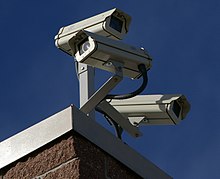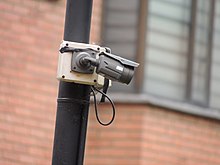
Back دائرة تلفزيونية Arabic Circuitu zarráu de televisión AST Qapalı dövriyyəli televiziya Azerbaijani Видеонаблюдение Bulgarian ক্লোজড সার্কিট টেলিভিশন Bengali/Bangla Circuit tancat de televisió Catalan Surveglianza Video Corsican Kamerový systém Czech Teledu cylch cyfyng Welsh Videoovervågning Danish



Closed-circuit television (CCTV), also known as video surveillance,[1][2] is the use of video cameras to transmit a signal to a specific place, on a limited set of monitors. It differs from broadcast television in that the signal is not openly transmitted, though it may employ point-to-point, point-to-multipoint (P2MP), or mesh wired or wireless links. Even though almost all video cameras fit this definition, the term is most often applied to those used for surveillance in areas that require additional security or ongoing monitoring (Videotelephony is seldom called "CCTV"[3][4]).
Surveillance of the public using CCTV is common in many areas around the world. Video surveillance has generated significant debate about balancing its use with individuals' right to privacy even when in public.[5][6][7]
In industrial plants, CCTV equipment may be used to observe parts of a process from a central control room, especially if the environments observed are dangerous or inaccessible to humans. CCTV systems may operate continuously or only as required to monitor a particular event. A more advanced form of CCTV, using digital video recorders (DVRs), provides recording for possibly many years, with a variety of quality and performance options and extra features (such as motion detection and email alerts). More recently, decentralized IP cameras, perhaps equipped with megapixel sensors, support recording directly to network-attached storage devices, or internal flash for completely stand-alone operation.
The deployment of this technology has facilitated significant growth in state surveillance, a substantial rise in the methods of advanced social monitoring and control, and a host of crime prevention measures throughout the world.[8]
- ^ Kumar, Vikas; Svensson, Jakob, eds. (2015). Promoting Social Change and Democracy Through Information Technology. IGI Global. p. 75. ISBN 9781466685031.
- ^ Dempsey, John S. (2008). Introduction to private security. Belmont, CA: Thomson Wadsworth. p. 78. ISBN 9780534558734.
- ^ Verman, Romesh. Distance Education In Technological Age, Anmol Publications Pvt. Ltd., 2005, pp.166, ISBN 81-261-2210-2, ISBN 978-81-261-2210-3.
- ^ "Distance education in Asia and the Pacific: Proceedings Of The Regional Seminar On Distance Education, 26 November – 3 December 1986", Asian Development Bank, Bangkok, Thailand, Volume 2, 1987
- ^ "What's wrong with public video surveillance?". ACLU. Retrieved 5 January 2017.
- ^ "Surveillance Cameras and the Right to Privacy". CBS News. 13 August 2010. Retrieved 5 January 2017.
- ^ "Best PoE Security Camera System". CBS News. 9 November 2019. Archived from the original on 28 January 2022. Retrieved 5 January 2017.
- ^ Caves, R. W. (2004). Encyclopedia of the City. Routledge. p. 114.
© MMXXIII Rich X Search. We shall prevail. All rights reserved. Rich X Search